|
Diamond Education
Vivo Signature Diamonds
Conflict-free Diamonds
Quick Diamond Guide
Jewellery Guide
Precious Metals
Proposal Tips
Custom Design
Customer Service
|
Conflict-free Diamonds
What are conflict-free diamonds? Vivo Diamonds only sell conflict free diamonds.
Next: Quick Diamond Guide >
Payment Method
For your convenience, Vivo Diamonds accepts the following forms of payments.
Free Shipping
Enjoy free shipping for all Singapore orders!
Next: Payment Method >
Price Match Guarantee
Our program gives you the confidence that you are paying the best price for your diamond.
Next: Free Shipping >
30 Days Return
Enjoy 30 days to get opinions so you can be 100% sure of your purchase.
Next: Price Match Guarantee >
AGS Lab Certification
Explaining AGS laboratory diamonds What is AGS? Founded in 1943, the American Gem Society (AGS) is dedicated to upholding the highest standards of ethics and integrity in the diamond and jewellery industries. Among the main priorities of the association is top-notch industry education, with numerous courses offered to jewellery professionals and consumers. The AGS laboratory is renowned for their scientific approach and research into diamond cut grading. Instead of using an alphabetical rating system, AGS uses a scale of 0-10 for rating a diamond’s characteristics, with 0 being termed “ideal”. 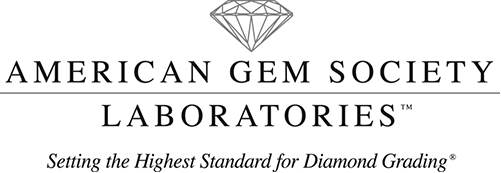 AGS diamond grading standards Every diamond graded by the AGS is analysed for its colour, clarity, and cut by at least two gemologists. Carat weight and proportions are measured using carefully calibrated computerized instruments. AGS uses a unique numerical grading system to quantify diamond colour, clarity, and cut. A grade of 0 indicates the rarest, most valuable quality, while a rating of 10 is the least desirable. Each number corresponds to a grade on the GIA's internationally accepted diamond grading scale. Which lab should I choose? AGS or GIA? Both AGS and GIA laboratories are very reputable and trusted laboratories, each have their own advantages and specialities. Whether to choose AGS or GIA-certified diamond very much depends on what your priority is. Speak to our jewellery expert online or call us at 6836-3789 to seek professional diamond advice. Click here to view our AGS-certified Vivo Signature diamonds > Next: Vivo Signature Diamonds >
GIA Lab Certification
Explaining GIA laboratory diamonds. What is GIA? The Gemological Institute of America (GIA) is one of the most respectable laboratories in the diamond industry. To jewellers and gemologists in the industry, they are a reliable source of information. Diamonds that are graded by this worldwide non-profit organisation, dedicated to produce consistent, accurate and unbiased grading reports, are the most highly valued in the industry. 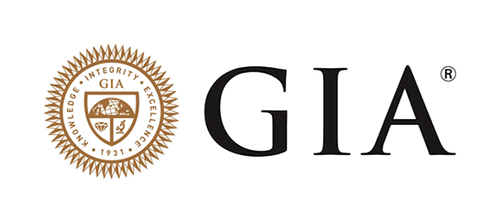 GIA diamond grading standards A GIA diamond grading report details an appraisal of the 4Cs and is the result of work from an entire team of gemologists. Trained eyes scrutinise the diamond using specific tools and analyse the ratios of the dimensions, clarity, colour, polish, symmetry and other elements before determining its grade. All GIA diamonds have a unique serial number laser inscribed on the girdle which enables you to match the diamond to its certification proving its authenticity. Buyer’s tip Ensure that your diamond certificate is kept in a safe place. The certificate provides invaluable security in the case of loss (helping to establish the quality and size of diamond required for equitable replacement), trade, or resale. Whenever the diamond must leave your possession (for example, to be cleaned), always let the party taking possession know you have a certificate. Knowing you can positively identify your diamond removes any temptation on the part of the third party to commit fraud (such as switching the diamond for one of lower quality). Most importantly, only buy diamonds which have been certified by a reputable lab. Do not accept certifications created by retailers, even if they claim to be GIA trained. Click here to view our extensive selection of GIA-certified diamonds > Next: AGS Lab Certification >
Fluorescence
There is a full spectrum of opinions on fluorescence in diamonds, read on to learn the facts. What is Diamond Fluorescence? Fluorescence is the reaction of trace minerals within the diamond that cause the diamond to glow when exposed to ultraviolet light. It is a characteristic that affects diamond colour and can occur in different intensities. Gemological laboratories measure the fluorescence of each diamond on a scale from "None" to "Very Strong". Fluorescence under UV light exposure  None - No fluorescence, no influence on colour Faint - Weak fluorescence, not a significant influence on colour Medium - Average fluorescence, small influence on colour Strong / Very Strong - Strong influence, substantial colour influence Is diamond fluorescence a good or bad thing? For diamonds in the normal range (D-J colours), fluorescence can affect the diamond appearance in two main ways. Fluorescence in diamonds may not necessary be negative. For H to J colour diamonds, they may actually benefit from the effect; the blue hue in the fluorescence can neutralise the yellowish tint in the diamond, making the diamond look 1- 2 colour grades higher than the actual colour grade.  To summarise If you are looking for H, I, or J colour, then a diamond with "medium" fluorescence can make your stone look slightly whiter. If not, your diamond will still look as good without it. But if you are buying a diamond with a G or higher colour, then find a diamond with either "none" fluorescence or "faint" fluorescence. Next: Diamond Grading >
Jewellery Making Process
We believe the best thing are still made by hand, see how we create each piece in our jewellery studio and workshop. The Layout
Once the design is finalised, the process of making the ring begins. A ring can be made in many different ways. The most frequently used approach is the lost wax casting process, the wax is being laid out to begin the sculpting of the model. Carving the Wax
The wax model is carved by hand (we also do CAD modeling). Skill and patience are required to carve the wax to the exact dimensions and form of the final piece. Spruing the Wax Model
Once the model is ready to be cast, it is sprued in place on the sprue base. The sprue becomes the channel that allows the metal to flow to the form of the ring. Pouring the Investment
The sprued wax model is placed within a crucible and then is filled with investment, which is a plaster-like compound that hardens around the sprued model. Melting the Metal
The crucible containing the sprued wax model is placed on a kiln for several hours until the wax and sprue are burned out, leaving a void within the plaster that is exactly the shape of the model. The metal is then melted in preparation for casting the ring. Casting the Ring
Here a vertical casting machine is spinning at extreme speed to produce a centrifugal pressure which forces the molten metal into the crucible and fills the form of the model. Cutting the Sprue from Rough Casting
The rough casting comes out of the crucible, covered in plaster and with a rough texture from the cooling of the molten metal. The sprue is cut off and the finishing begins. Finishing the Rough Casting
Now the rough casting is cut, filed, sanded, and polished to the completed form of the ring. This could be the last step in some projects, but there is more to come. Setting the Rough Stone
The finished casting is now ready for more precise details like stone setting and engraving. Here the seat is cut and the metal hammered to hold the diamond centre stone. Polishing the Ring
Once the stone setting is complete, it is time for the final polishing. Using high speed wheels with different compounds, the ring is brought up to its final polish and ultimate finish. Quality Control
Every piece goes through extensive quality control to ensure the precision and craftsmanship is impeccable. At this point an appraisal would also be made on the finished ring. Viola!
The final piece is complete and ready for a loving home! Custom CAD Designs >
Custom Design Process
See how our rings are custom made to suit every client's needs. We specialise in custom jewellery design and are really good at it because we do it every day...and we love it At every step of the process we encourage the client to express the opinions and be involved in the process.We want each project to reflect the client's own personal style and taste and for each and every client to be absolutely delighted with the final product.
Jewellery Making Process >
Custom CAD Designs
Our selection of custom-designed engagement rings is constantly growing, visit our store to view the full collection. 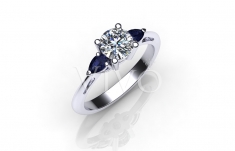 Three Stones Sapphire Diamond Ring Three Stones Sapphire Diamond Ring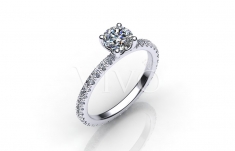 Pave Set 4 Prongs Diamond Ring Pave Set 4 Prongs Diamond Ring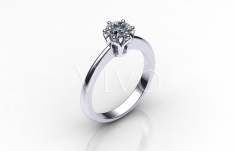 6 Prongs Classic Diamond Ring 6 Prongs Classic Diamond Ring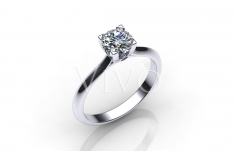 Velma 4 Prongs Solitaire Ring Velma 4 Prongs Solitaire Ring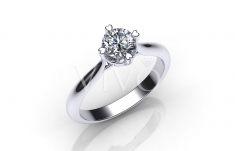 Classic 4 Prongs Solitaire Ring Classic 4 Prongs Solitaire Ring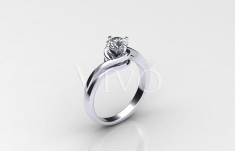 Twist Solitaire Ring Twist Solitaire Ring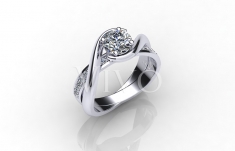 Revolve Solitaire Ring Revolve Solitaire Ring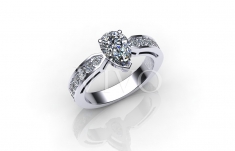 Pear Brilliant Pave Set Ring Pear Brilliant Pave Set Ring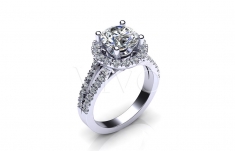 Halo Split Shank Solitaire Ring Halo Split Shank Solitaire Ring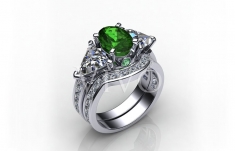 Emerald Three Stones Pave Set Ring Emerald Three Stones Pave Set Ring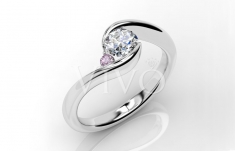 Pink Diamond Side-stone Ring Pink Diamond Side-stone Ring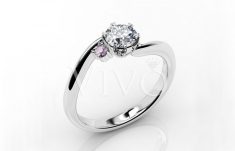 Pink Diamond Side-stone Ring Pink Diamond Side-stone Ring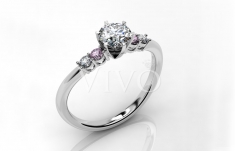 Pink Diamond Side-stone Ring Pink Diamond Side-stone Ring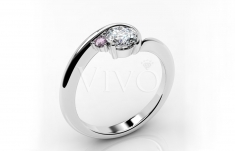 Pink Diamond Side-stone Ring Pink Diamond Side-stone Ring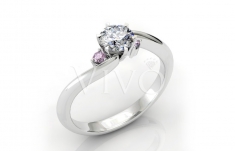 Pink Diamond Side-stone Ring Pink Diamond Side-stone Ring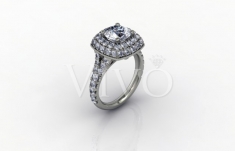 Grace Split Shank Solitaire Ring Grace Split Shank Solitaire Ring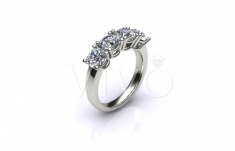 Four Stones Ring Four Stones Ring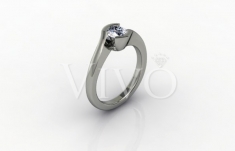 Semi Bezel Solitaire Ring Semi Bezel Solitaire Ring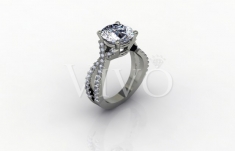 Pave Set Solitaire Ring Pave Set Solitaire Ring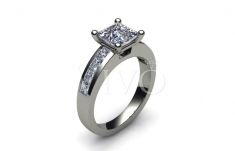 Princess Cut Diamond Ring Princess Cut Diamond RingCreate Your Own >
The 4Cs - Cut
Find out why the diamond cut is an important attribute of a diamond. How are diamonds cut? For instance, one rough diamond crystal can be cut to yield either 2 ideal proportion stones with smaller carat size, or 1 deeper cut stone with a larger carat size. Why is the cut of a diamond so important? Two diamonds of the same carat weight but with different cut may have difference in their appearance; for example, an ideal cut diamond will look larger as compared to a deep cut diamond. Thus it is essential to choose a diamond with better cut quality.  The diamond below illustrates the ideal perimeters to qualify as our Signature diamond.  The chart below shows the ideal Crown angle and Pavilion angle combinations for Hearts & Arrows Ideal Cut as well as our Signature ideal cut diamond combinations. 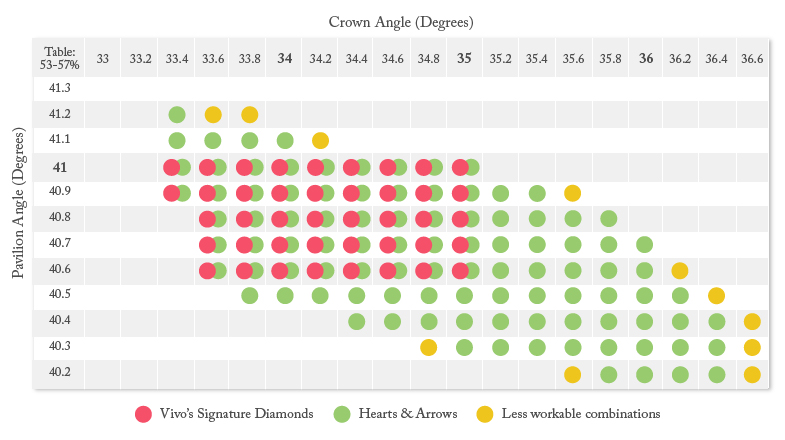 Next: Carat Weight >
The 4Cs - Carat Weight
Find out how big the diamond looks like for different carat weight. Carat size Diamond price increases with carat weight, because larger diamonds are rarer and more desirable. But two diamonds of equal carat weight can have varied values and prices, depending on three other factors in the 4C; clarity, colour, and cut. The chart below gives you an estimation of the diamond size based on the carat weight. 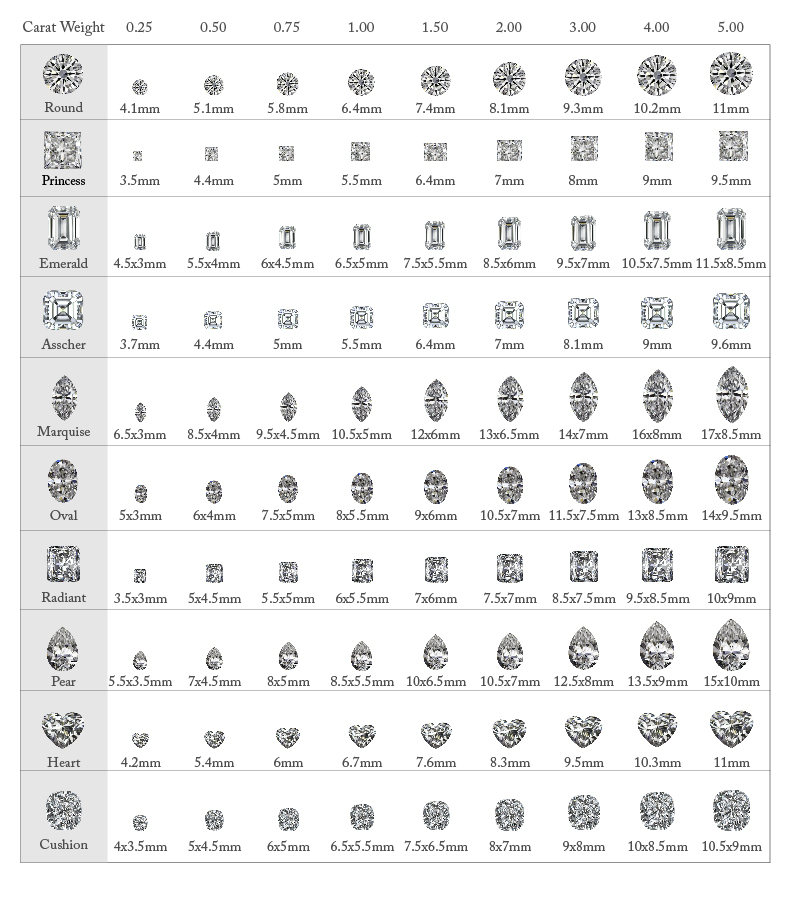 Next: Colour >
The 4Cs - Colour
Learn about what affects the diamond colour and decide which colour is ideal for you. GIA Colour Grading The colour evaluation of most gem-quality diamonds is based on the absence of colour. A chemically pure and structurally perfect diamond has no hue, and consequently, holds a higher value. D colour diamonds are completely colourless, while Z colour diamonds look yellowish or brownish. For diamonds with colour that fall beyond the normal colour range, the Fancy Colour Grading Scale is then used. Fancy colour diamonds come in a variety of colours; from brown, grey and yellow which are more common, to red, blue and pink which are the rarer ones. 
Next: Clarity >
The 4Cs - Clarity
Learn about what affects the diamond colour and decide which colour is ideal for you. GIA Clarity Grading Clarity measures the presence or absence of flaws or inclusions (internal flaws) in a diamond. The fewer flaws a diamond have, the higher its grade.  IF: No internal flaws, but will show minimal surface flaws. VVS1-VVS2: Tiny inclusions can be detected under 10x magnification by a trained gemologists. VVS2 has slightly more inclusions than VVS1. VS1-VS2: Minor inclusions visible under 10x magnification. Typically cannot see inclusions with the naked eye. VS2 has slightly more inclusions than VS1. SI1-SI2: Inclusions visible under 10x magnification but usually not visible with the naked eye. SI2 has more inclusions than SI1. I1-I3: Inclusions visible to the naked eye. Not carried by Vivo Diamonds. Diamond examples Here are some of our actual diamond images under 10x magnification for clarity grading comparison. 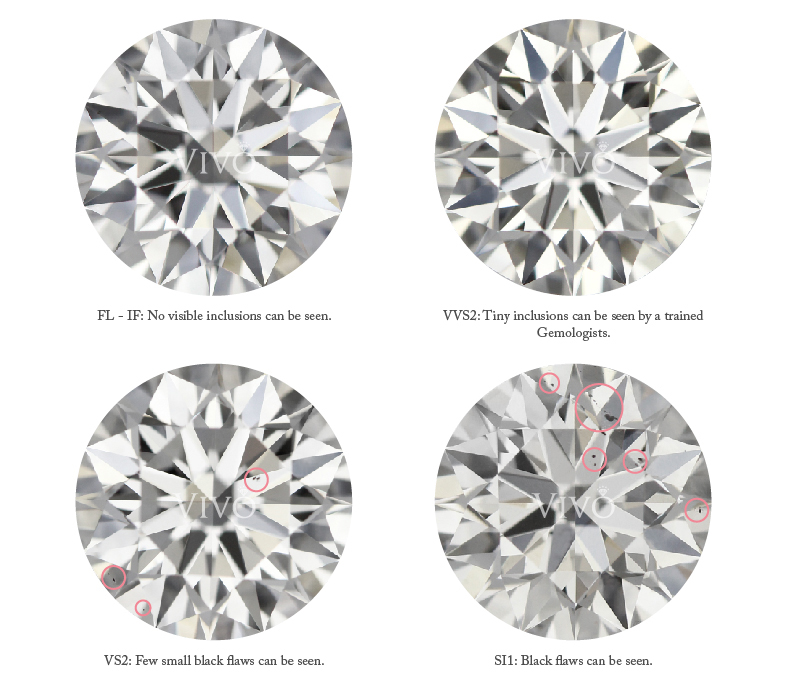 Next: Fluorescence >
Diamond Grading
Read on to learn how a diamond is graded using different tools. Diamond Grading Tools The following tools are commonly used in assessing and viewing a diamond: Ideal scope, ASET scope, and Hearts & Arrows viewer. 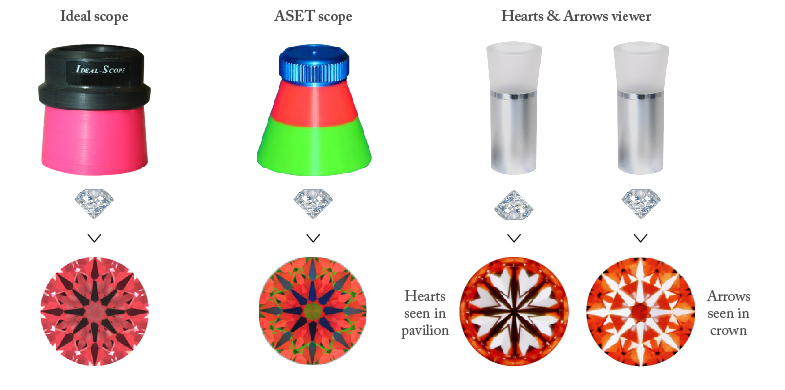 Ideal scope: Creates structured light environment. Shows indications of light return, symmetry and proportions. ASET scope: Reveals light leakage within and around a diamond. Shows light performance of a diamond. Hearts & Arrows viewer: Used for viewing Ideal cut round brilliant diamonds. Reveals any deformation or absence of Hearts or Arrows. Grading with Ideal scope The reference chart below shows the light return, symmetry and proportions of a diamond using the Ideal scope. 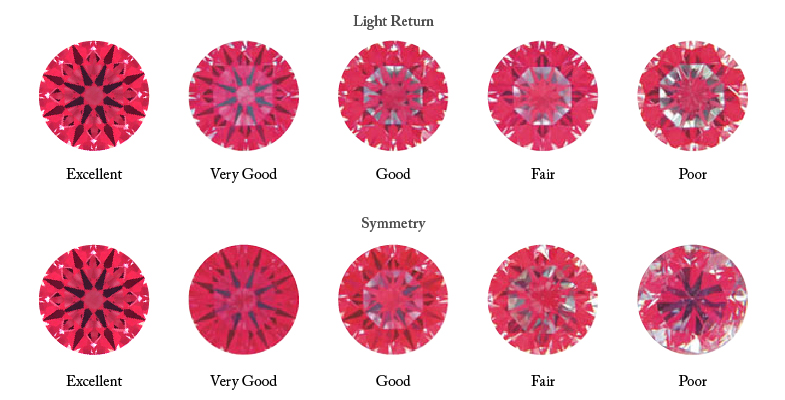 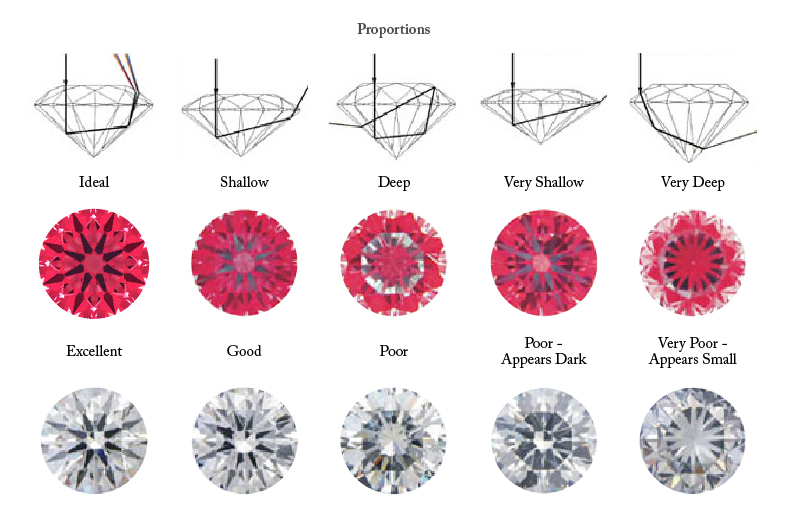 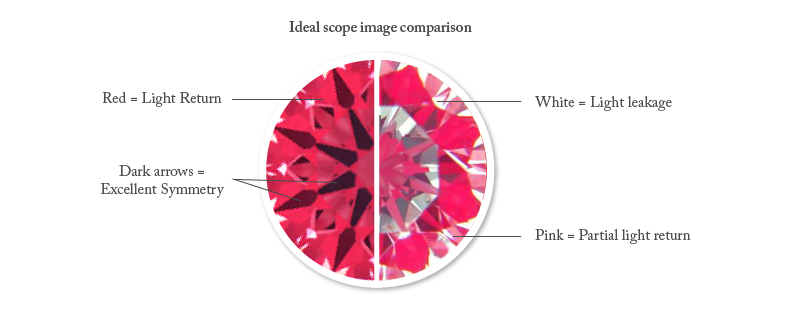
The 3 colours seen in an ASET scope image represents 3 kinds of light that is directed to the diamond; green for reflected light, red for direct light, and blue for obscured light. To determine whether the diamond has an excellent light performance grading, the ASET scope image must reflect a perfect balance of these 3 colours. The following examples illustrate the different light performance grading.  Hearts and Arrows diamonds are cut to ideal proportions with superior optical symmetry and a specific faceting pattern. When all these factors are in harmony, the result is a repeatable, near perfect pattern of eight symmetrical arrows in the face up position and eight symmetrical hearts when viewed in the table down position.  Poorly formed Hearts result in no Hearts & Arrows in the diamond while perfect symmetrical Hearts result in perfectly formed Arrows in the diamond. Next: Popularity Ranking >
Popularity Ranking
See what are the popular choices among our customers. View the most popular choice in each diamond attribute. 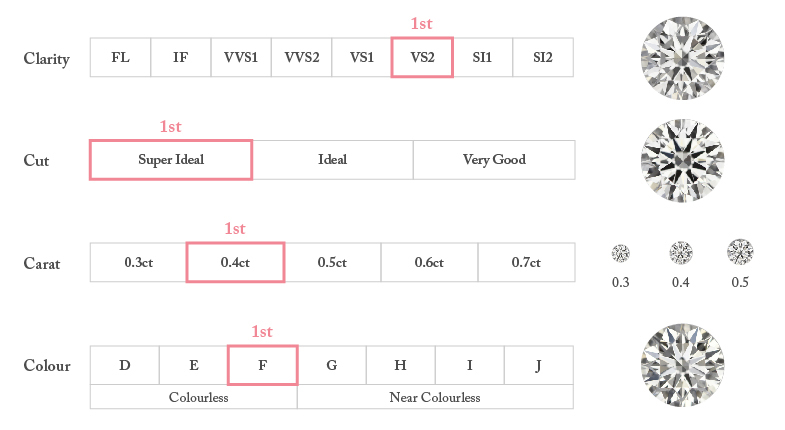 The following charts will give you a guide to the popular diamond range. Diamonds ranging between clarity VVS2 - VS2, and D - G colour for our Vivo Signature Triple Ideal cut diamonds are pretty popular amongst our clients. As for our GIA Triple Excellent cut range, between clarity VS1 - SI1, and E - H colour are well liked by our clients. 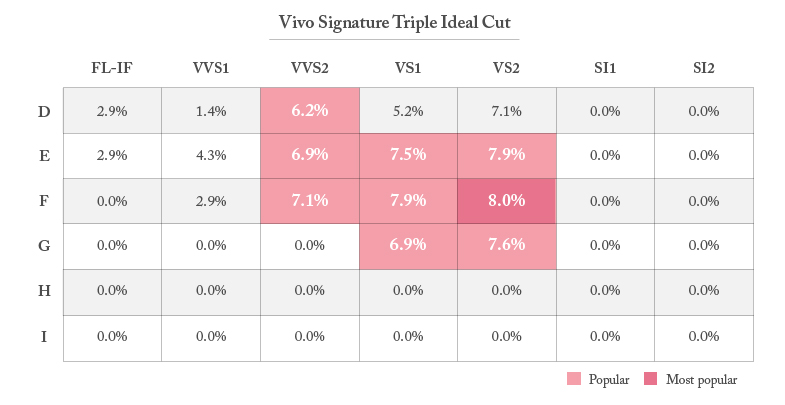 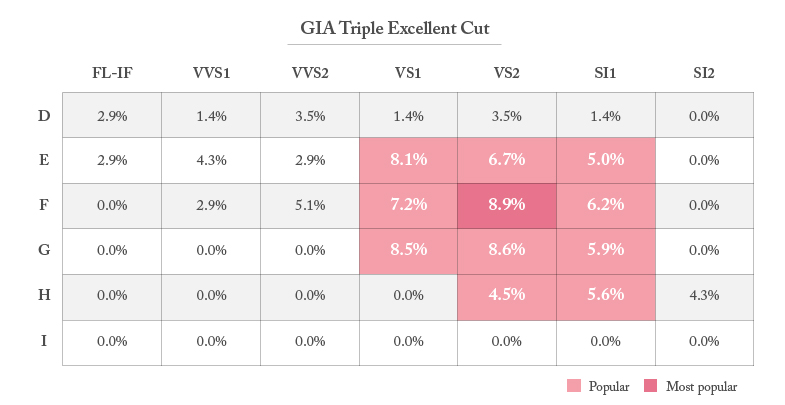 Next: GIA Lab Certification >
Vivo Signature Diamonds
Learn about the world's most dazzling diamonds cut to perfection. 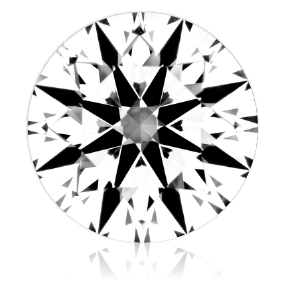
Vivo Signature Diamonds Our signature diamonds are manufactured with less than 1000 diamonds per year. Created by specialised ideal cut diamond cutting factory, virtually unheard-of in today’s mass-manufacture world. The goal is precisely the same for every signature diamond; identical cutting to achieve the highest possible light performance. Every signature diamond is high inside the top 1% of all diamond cut quality. Every diamond has the AGS Ideal light performance grade from the American Gem Society (AGS). The diamond earns top marks in the most modern cut performance grading systems. No other cutter boasts as much strict and abundant proof of high performance as our signature diamonds. Browse Vivo Signature diamonds >
Conflict-free Guarantee Our diamonds are produced in accordance with the United Nations Kimberley Process, Belgian Federal AML compliance, the United States Clean Diamonds Act and the voluntary JVC-USA Patriot Act Compliance Program in co-operation with legitimate sources not involved in funding conflict. Vivo Signature Diamonds are guaranteed to be conflict-free based on personal knowledge and/or written guarantees with partners who share a kindred commitment to humanitarian rights and “green” practices. Learn more about conflict-free diamonds >
Next: Conflict-free Diamonds >
Jewellery Guide
Useful tips on taking care of your fine jewellery 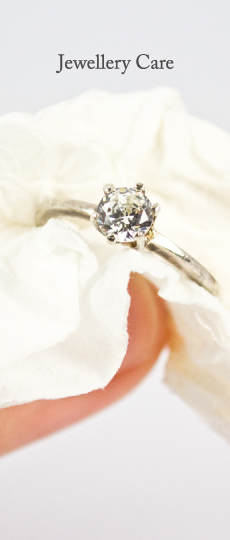 Jewellery Care
Jewellery Care Store each piece separately when you're not wearing them to prevent scratches. Store each piece separately when you're not wearing them to prevent scratches. Do not wear rings and jewellery while doing laborious work such as sports, gardening, and etc.This is because doing so may bend jewellery and stones can be lost. Do not wear rings and jewellery while doing laborious work such as sports, gardening, and etc.This is because doing so may bend jewellery and stones can be lost. If you take your jewellery off while out and about, do not leave them in the bottom of your bag.Keep a little soft pouch or box in your bag for safe keeping. If you take your jewellery off while out and about, do not leave them in the bottom of your bag.Keep a little soft pouch or box in your bag for safe keeping. Put your jewellery on last when getting ready in the morning to avoid direct contact with perfumes, hairsprays, cosmetics and other body products, and be extra careful not to get solvents and sprays on precious stones. Put your jewellery on last when getting ready in the morning to avoid direct contact with perfumes, hairsprays, cosmetics and other body products, and be extra careful not to get solvents and sprays on precious stones.
Cleaning Your Jewellery If you're not sure how to clean your jewellery, simple come to us and we will do it for you! If you want to have a go at home, the process depends on what you're cleaning. Gold, Platinum or Diamonds: White and yellow gold, platinum and diamonds can be cleaned with soapy water and a soft brush. The best result come from a professional buff to remove scratches and ultrasonic cleaning which can be done in our store by our expert jewellers. Coloured stones: All natural coloured stones have different propertics and characteristics. Ruby and sapphire stones can be cleaned safely as you would do with a diamond. Emeralds require special care as they are very delicate, hence we recommend emeralds to be cleaned professionally by a jeweller. Next: Precious Metals >
Quick Diamond Guide
Learn how to select the perfect ring and diamond. 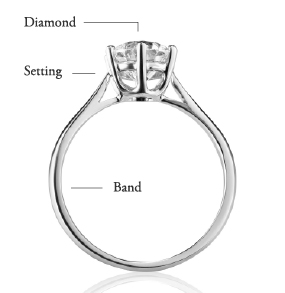 Elements of an Engagement Ring
Elements of an Engagement RingThe diamond will most likely account for most of the overall cost of the ring. Educating yourself on the four Cs will ensure the making of an informed decision. The setting, also referred to as the head, is the part that holds the diamond in place and is manufactured to fit the size and shape of the diamond you choose. The two main types are either prong or bezel settings. With round diamonds, you will have an option of either four or six-prong. A four-prong setting shows a bit more diamond, while a six-prong setting offers a slight security advantage. The band, also referred to as the engagement ring setting, is available in a variety of styles from the classic solitaire to diamond accented styles. Your choices of metals are 14k white or yellow gold, 18k white or yellow gold, and platinum. Some engagement settings are also available in two-tone. How to choose the ideal engagement ring?
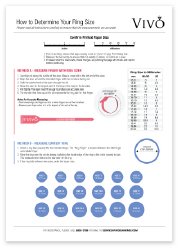 What is my ring size?
What is my ring size?We provide a printable ring sizer that can help you determine your ring size. View Ring Sizer Prior to printing, ensure that the paper is printed in actual size (100%). (The document is a PDF file and it requires Adobe Acrobat Reader. Download Adobe Acrobat Reader for free.) Things to note while measuring ring size - Confirm the printed paper size with a ruler. - Pull tightly. The sizer must fit snugly to produce an accurate size. - Do not measure cold fingers. This is when fingers are at their smallest. - For the most accurate reading, measure your finger at the end of the day when it is largest. Tips for buying ring as a surprise - Ask your partner's mother or one of her friends if they know her finger size. - Borrow one of your partner's rings (from the correct finger) and use the Ring Sizer PDF to determine the size. What if it’s the wrong size? Don't worry if you've ordered the wrong size. If it is within 30 days of shipment, ring us up at 6836-3789 to set up your return for resizing. Just ship the ring back to us, and we'll get it resized for free. All rings listed on Vivodiamonds.com are in USA size. Next: Jewellery Guide >
Precious Metals
Learn about the different types of precious metals used in making fine jewellery.
About Gold
Gold has been the inspiration for jewellery since the beginning of time. It is coveted for its gleaming beauty and strong yet malleable nature. Gold will not rust, corrode or tarnish. Gold is measured in karats, abbreviated as the letter "K" and preceded by a number. 100% pure gold is 24K. However, in its pure form, gold is too soft to be used in jewellery. In order to give it resilience to hold up to everyday wear, gold is alloyed with other metals.
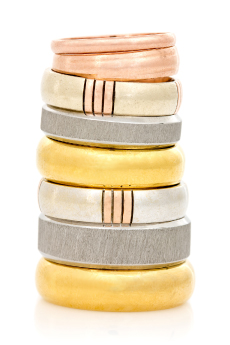 Types of gold
Types of gold• Yellow Gold: Vivo Diamonds offers both 14k and 18k yellow gold settings for our diamond jewellery. If you prefer a deep, rich, golden colour, we recommend 18k. Many people also enjoy the traditional colour of 14k yellow gold. The choice is entirely up to you. • White Gold: We offer both 14k and 18k white gold settings. Although much whiter in colour than yellow gold, 14k white gold has a subtle yellow hue as it is made with 58.3% yellow gold. For a whiter colour, rhodium is plated over our 14K white gold settings. (Rhodium is a hard, durable, silvery-white metal.) Rhodium plating wears off eventually. Your local jeweller can easily re-plate the rhodium finish on your jewellery to restore its shiny white colour. Your 14K white gold jewellery should be re-plated about once a year. • Rose Gold: Rose gold jewellery has become one of the popular choices in the 21st century and is commonly used for wedding bands, bracelets, and other jewellery. Vivo Diamonds offer 18K rose gold. Pricing of gold The price of gold jewellery is based on the purity of gold used or karat weight, as well as the design and craftsmanship of the piece. With greater karat weight comes a higher purity of gold, a heavier piece of jewellery, and greater cost.
About platinum
Platinum, like gold, has a long and distinguished history and remains one of the world's rarest metals. It can only be found in very few regions of the world - South Africa is the leading platinum-producing country. Platinum is far more valuable than gold, and more expensive. Platinum’s unique cool white sheen makes platinum a popular choice for settings, as it accentuates the sparkle and brilliance of a diamond like no other. Platinum is often the precious metal of choice to produce the finest jewellery with the most valuable gems, as it is tarnish and scratch-resistant. Characteristics of Platinum The most appealing characteristic of platinum is its strength and durability - it is by far the strongest and most durable precious metal. Each time other metals are scratched or polished, a small amount of metal is lost. However, platinum will not chip or splinter easily. Platinum is an alloyed group of six closely related metals - platinum, palladium, rhodium, ruthenium, iridium, and osmium. Today, it is often alloyed with titanium and copper. Most platinum jewellery is 95% pure platinum mixed with 5% iridium, palladium, or ruthenium alloy for added strength. It can also be 90% pure platinum with 10% alloys. To guarantee its quality, each piece of jewellery should be stamped with "950 Plat" indicating 95% purity or "900 Plat" indicating it is 90% purity. Because of its purity, platinum is ideal for people who are allergic to other metals as it rarely causes any reaction. Pricing of Platinum Compared to gold, platinum is heavier, rarer, and more valuable. It is also more durable than gold and sold in purer form. Platinum is not sold by karat weight. Platinum's density and weight give it a different feel from other precious metals and is almost twice as heavy as 14k gold. This heaviness when used in fine jewellery is one of platinum's strongest selling points, as people tend to equate weight with value. Next: Proposal Tips >
Proposal tips
Read the dos and don'ts of marriage proposals before you get down on one knee.
Talk about marriage
Before you propose, talk about the possibility of getting married. Make sure it's something that you both want, and agree on major issues such as children.
Know if she wants to pick the engagement ring
Most brides want their proposal to include an engagement ring, but others are very particular about their jewellery, and want to be part of the buying and designing process.
Drop to one knee
It's not 1950, but there is something so charming and romantic about a man on one knee asking the love of his life to marry him. Even if you're not a traditional guy, it will add to the seriousness and lovingness of the proposal.
Make it a surprise
Even though you have discussed marriage, the proposal itself should still be a surprise. Find a moment and a way that she won't be suspecting.
Find the right ring
An engagement ring is for a lifetime; make sure it's the right one. Shop for rings while walking past a store, or bring it up in a conversation. You can also ask for advice from her mother or best friend.
Pick a personal spot
Think about your favourite romantic places. It could be as simple as in your living room, or as elaborate as whisking her away for a weekend in Paris. Just don't ask her in a supermarket aisle!
Talk to her parents
We've come a long way from when women were properties who needed their father's permission, yet, it is still a nice and respectful gesture to ask for her parents' blessing.
Be creative
Incorporate your personality, favourite things, food, and etc. into the proposal. Make it memorable rather than a cookie cutter proposal.
Make it public
Unless she said she wants a splashy proposal, make it an intimate and personal thing. Most brides would prefer to have that magical moment be just the two of you.
Hide the engagement ring in food
This idea had been in a thousand movies and TV shows, and you won't win any points for creativity. You wouldn’t want to end your romantic proposal with a trip to the emergency room or the dentist.
Make it too complicated
While it's good to be creative with your proposal, it is important to keep the focus on the proposal itself. If you are worrying about whether or not the limousine will get to the balloon ride in time, you're worrying about the wrong thing.
Propose at a sports game
Games can be loud and chaotic. Even if she is the biggest sports fan you know, the arena wouldn’t allow her to focus on making such a momentous decision.
Propose too early in the relationship
When you're in the first flush of love, it's hard not to do impetuous and foolish things. Yet waiting until your relationship is stable will only strengthen your marriage. Make sure you truly know each other before you commit to it for the rest of your lives.
Propose in front of her family
Doing so may create unnecessary stress for your lady. Take this moment to be just the two of you; don't worry, you can call everyone immediately afterwards.
Expect her to say yes immediately
You're asking someone to spend the rest of their life with you – an extremely important decision. Just because you've asked, doesn't mean she is ready to say yes. If your sweetheart says maybe, take it in stride and give her some time to consider the proposal.
Credits: Nina Callaway
Share your story An engagement can be one of the most exciting and joyful moments of a person's life, so share your proposal story with the world. Was it romantic or adventurous? Was it a private moment, or was the proposal in a public place? Either way we’d love to hear it from you! Email your story to [email protected] and published stories will receive a $100 gift voucher for your next purchase at Vivo Diamonds. Custom Design Process >
|
|||||||||||||||||||||||||||||||||

 BOOK AN APPOINTMENT
BOOK AN APPOINTMENT 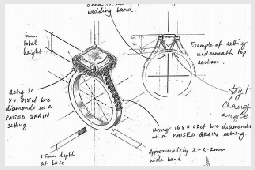
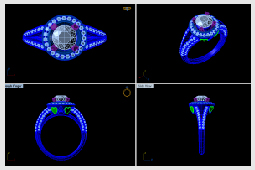
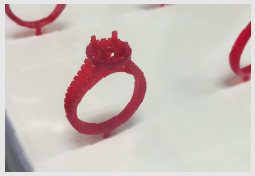
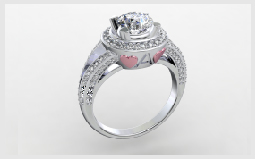


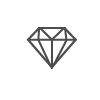
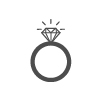
 100 Peck Seah Street PS100 #08-01 Singapore 079333
100 Peck Seah Street PS100 #08-01 Singapore 079333 Mon - Sat: 12pm - 8pm
Mon - Sat: 12pm - 8pm
 (+65) 6836 3789
(+65) 6836 3789